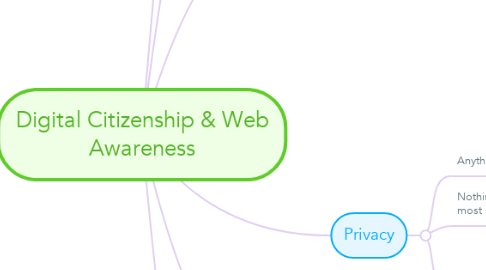
1. Internet Safety
1.1. cyberbullying
1.1.1. best response is pro-active and preventative
1.1.2. term "cyberbullying" often has little meaning to students
1.1.2.1. students see is as "starting something", getting ingto fights, and "drama."
1.1.3. what happens online is everybody's business
1.1.4. SnapChat
1.1.4.1. hard to catch cyberbullying from this platform because the message and picture/video is erased after viewing.
1.2. Sexting
1.2.1. Can lead to cyberbullying
1.2.1.1. boys are more likely to forward a sext.
1.2.1.1.1. pressure to share sexts sent to them
1.2.2. occurs in three contexts
1.2.2.1. pre-sexual activity for adolescents who are not physically sexually active yet
1.2.2.2. to show interest in someone
1.2.2.3. proof of trust and intimacy
1.2.3. More common in adults than teens
1.2.4. Gender Roles
1.2.4.1. boys gain status
1.2.4.2. inapropriate behavour for girls
1.2.4.2.1. seen as "slut" or "insecure" when they do send sexts
1.2.4.2.2. seen as "prude" or "stuck up" when they don't
1.2.4.2.3. lose-lose situation for girls. (harsh & sexist)
1.3. In Loco Parentis
1.3.1. teacher stands as legal guardian when parent is not present.
2. Digital Citizenship
2.1. media literate in the 21st century
2.2. ethical core & ethical behaviour is the number one concern.
2.3. Preparing students not shielding them.
2.4. not just using it, but thinking more deeply about it
2.5. Not just consumers anymore, we are creators.
2.6. Students lack basic skills to protect themselves online.
2.7. 5 Ethical Issues:
2.7.1. identity
2.7.2. Privacy
2.7.3. Ownership
2.7.4. Trustworthiness
2.7.5. Participation
3. Authenticity of Web Resources
3.1. Critical Consumers
3.1.1. not everything on the internet is true
3.1.2. learn how to know if a website is reliable
3.1.2.1. fact check it using other websites.
3.1.2.2. check key words
4. Marketing that Targets Kids
4.1. Breakfast (95%)
4.2. restaurants (98%)
4.3. clothing (95%)
4.4. Software (76%)
4.5. Computers (34%)
4.6. entertainment (98%)
4.7. trips & excursions (94%)
4.8. Budget shortfalls allows corporations access to studetents
4.8.1. supplying technology
4.8.2. advertising
4.8.2.1. classrooms
4.8.2.2. busses
4.8.2.3. computers
4.8.3. sponsoring school events
4.8.4. contests & incentive programs
5. Privacy
5.1. Anything you post online can be searched
5.2. Nothing is 100% private even at most secure privacy settings
5.3. Geo-tagging
5.3.1. pictures posted on social media leave details to where picture was taken.
5.3.2. Facebook & Instagram check-ins
6. Copyright
6.1. creative commons
6.2. moral obligation
6.2.1. modleing documenting sources
6.2.2. ethical use of technology
6.2.2.1. implications of using pirated software
6.2.2.2. what happens to people who plagiarize in the real world.
